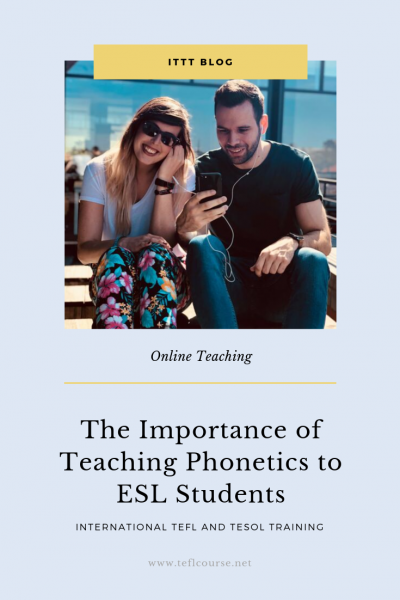The Importance of Teaching Phonetics to ESL Students

How many of us have had to call into customer service only to struggle to understand the employee’s English? The simple process to find a solution to a problem often becomes increasingly frustrating and exhausting for both parties. While monolinguistic persons may not appreciate the struggle to learn and master a new language, as instructors to those individuals working to learning English, phonetics is key.
This post was written by our TEFL certification graduate Antranik D. Please note that this blog post might not necessarily represent the beliefs or opinions of ITTT.
English alphabet
The modern-day English alphabet does not visually represent the range of phonetic sounds utilized by the language and this presents struggles especially for English learners. Who cares if you recognize and know how to spell the words if you can’t speak them? Phonetics is incredibly important for anyone who is learning a foreign language. I would go so far as to say that phonetics is just as important as anything else taught in a foreign language class.

Also Read: How long does a TEFL course take?
Why do students need phonetics?
Phonetics allows teachers and students to examine the differences between the source of sounds and the target language that is being learned. The study of phonetics enables students to better understand and speak at a level close to fluent. Even as a native English speaker, I found the phonetics course rather frustrating because I was never taught phonetic transcription during primary school. It would have been a very valuable resource to break apart and enunciate larger, more irregular words. Prioritizing the implementation of phonetics into TEFL courses will be advantageous to new English learners in helping them understand the physiological workings of language and better improve their ability to communicate and be understood.
How to teach phonetics effectively?
Throughout the chapter on phonetics, it became readily apparent that a beneficial strategy for TEFL students would be to have a visual representation of the parts of the mouth/tongue/throat used to form the sound components of words. English has many words that are spelled similarly but have a different emphasis on syllables, thus making the word sound completely different. A prime example of this sound inconsistency is seen in the following words: “trough”, “rough”, “through”, and “bough”.
While all these are spelled similarly, the phonetics of each word given has a different vowel sound. Similarly spelled words that have very different enunciations can prove challenging and frustrating to distinguish. By combining the phonetic spelling of words with images of how to form the sounds, this will help alleviate the stresses of a learner’s ability to be understood. Not only will it help classrooms run smoothly, but it will also enable learners to accurately practice outside the classroom without fear of being misunderstood.

Also Read: Maintaining Discipline in The Classroom
Practice in isolation
Another great thing gleaned from phonetics is the ability to isolate sounds. If there is a sound that a learner is struggling with, providing practice examples that have the target sounds in them allows instructors, like me, to easily identify and practice the necessary place of articulation that will best help our struggling learners. The ability to localize lessons like this will build confidence in the individual student in his or her ability to “sound correct” or fluent. While fluency may be an end goal for learning a foreign language, having confidence in the fact that what you’re doing is audibly improving your speech can do a great deal in raising student confidence levels.
Do you want to teach English abroad? Take a TEFL course today!
In conclusion, the focus of a foreign language class should not only be vocabulary. A learner may have a large vocabulary, but if that learner cannot enunciate half the words he or she knows, then what good is knowing them? Communication is the goal of learning any language and mastery of communication isn’t just a mastery of vocabulary. One must be able to coherently communicate to one’s peers and native speakers. Fluency is reflective of the ability of a person to be understood rather than on the amount that is needed to be known, thus phonetics should be one of the larger focuses in designing and implementing an ESL curriculum.
Apply now & get certified to teach english abroad!
Speak with an ITTT advisor today to put together your personal plan for teaching English abroad!
Send us an email or call us toll-free at 1-800-490-0531 to speak with an ITTT advisor today.
Related Articles:
- How do I get a job teaching English in South Korea
- 10 Questions You Need to Ask Before Enrolling In a TEFL Course
- The 10 Best Destinations for Teaching English Abroad in 2018
- Online or In-Class - Which TEFL Course Should You Take?
- The Best Government Programs For Teaching English Abroad
- What Scams to Look Out for When Looking for TEFL Jobs




